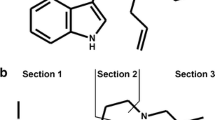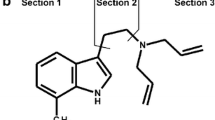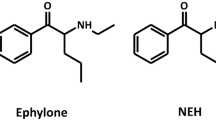Abstract
In order to use for metabolic studies of tranylcypromine (TCP), TCP-phenyl-d5 was synthesized via the intermediates, 3-benzoylpropionic acid-d5 andtrans-2-phenylcyclopropanecarboxylic acid-d5. TCP (0.22 mmole/kg) and its deuterated analog were administered s.c. to the rats and GC/MS analyses of the urines led to the detection of N-acetyltranylcypromine (ATCP) and glucuronide conjugate of phenyl-hydroxylated ATCP. MAO activities in rat brain were measured using serotonin as the substrate.In vitro IC50 of ATCP was determined to be 10−3 M. The inhibitions by ATCP were not dependent on the preincubation time and were reversed by washing sedimented mitochondrial pellets after the preincubation.In vivo MAO inhibitions at various times of 0.5, 1.5, 3, 6, 12, and 24 hr after the administration of 0.4 mmole/kg (i.p.) of ATCP were found to be 0, 13, 73, 90, 89, and 74% respectively. Similarly, the inhibition percents by 0.015 mmole/kg (i.p.) of TCP were 94, 99, 95, 91, 71, and 49%. The results strongly suggest that deacetylated product of ATCP may account for itsin vivo MAO inhibition. The relationship between the metabolism via phenyl-hydroxylation and thein vivo potency of TCP was examined by QSAR study and it was found that groupings discriminating between the compounds withp-substituents and those without them only ensure high correlations, suggesting that ring-hydroxylation which occurs at the para position in most of the compounds is a determining factor to the potency of TCP.
Similar content being viewed by others
Literature Cited
Kang, G.I.: Mechanism of the monoamine oxidase inhibition.Yakhak Hoeji 27, 321 (1983).
Paech, C.P., Salach, J.I., and Singer, T.P.: Suicide inactivation of monoamine oxidase bytrans-phenylcyclopropylamine.J. Biol. Chem. 255, 2700 (1980).
Silverman, R.B.: Mechanism of inactivation of monoamine oxidase bytrans-2-phenylcyclopropylamine and the structure of the enzyme-inactivator adduct.J. Biol. Chem. 258, 14766 (1983).
Silverman, R.B., and Hoffman, S.J.: N-(1-Methyl) cyclopropylbenzylamine. A novel inactivator of mitochondrial monoamine oxidase.Biochem. Biophys. Res. Commun. 101, 1396 (1981).
Silverman, R.B., and Yamasaki, R.B.: Mechanismbased inactivation of mitochondrial monoamine oxidase by N-(1-methylcyclopropyl) benzylamine.Biochemistry 23, 1322 (1984).
Youdim, M.B.H., Aronson, J.K., Blau, K., Green, A.R., and Grahame-Smith, D.G.: Tranylcypromine (parnate) over-dose: Measurement of tranylcypromine concentrations and MAO inhibitory activity and identification.Psychol. Med. 9, 377 (1979).
Reynolds, G.P., Rausch, W.-D., and Riederer, P.: Effects of tranylcypromine stereoisomers on monoamine oxidation in man.Brit. J. Clin. Pharmacol. 9, 521 (1980).
Calverley, D.G., Baker, G.B., Coutts, R.T., and Dewhurst, W.G.: A method for measurement of tranylcypromine in rat brain regions using gas chromatography with electron capture detection.Biochem. Pharmacol. 30, 861(1981).
Kang G.I.: The use of stable isotope compounds in pharmaceutical research.J. Korean Pharm. Sci. 14, 145(1984).
Kang, G.I., and Chung, S.Y.: Identification of N-acetyl and hydroxylated N-acetyltranylcypromine from tranylcypromine-dosed rat urine.Arch. Pharm. Res. 7, 65(1984).
Levitt, M.J.: Rapid methylation of micro amounts of nonvolatile acids.Anal. Chem. 45, 618(1973).
Kang, G.I., and Hong, S.G.: Synthesis and mass spectrometry of deuterium labeled tranylcypromine hydrochloride.Arch. Pharm. Res. 8, 77(1985).
Somerville, L.F., and Allen, C.F.H.: β-Benzoylpropionic acid.Org. Syn., Coll. Vol.2 81 (1943).
Kaiser, C., Lester, B.M., and Zirkle, C.L.: 2-Substituted cyclopropylamines. I. Derivatives and analogs of 2 phenylcyclopropylamine.J. Med. Pharm. Chem. 4, 1243 (1962).
Tedeschi, R.E.: Monoamine oxidase inhibition.U.S. Patent 2,997,422 (1961).
Sjoerdsma, A., Smith, T.E., Stevenson, T.D., and Udenfriend, S.: Metabolism of 5-hydroxytryptamine (serotonin) by monoamine oxidase.Proc. Soc. Exptl. Biol. Med. 89, 36(1955).
Udenfriend, S., Weissbach, H., and Clark, C.T.: The estimation of 5-hydroxytryptamine (serotonin) in biological tissues.J. Biol. Chem. 215, 337(1955).
Lawry, O.H., Rosebrough, N.J., Forr, A.L., and Randall, R.T.: Protein measurement with the Folin phenol reagent.J. Biol. Chem. 193, 265 (1951).
Zirkle, C.L., Kaiser, C., Tedeschi, D.H., and Tedeschi, R.E.: 2-Substituted cyclopropylamines. II. Effect of structure upon monoamine oxidase-inhibitory activity as measuredin vivo by potentiation of tryptamine convulsions.J. Med. Pharm. Chem. 5, 1265 (1962).
Hansch, C., and Fujita, T.: ρ-σ-n Analysis. A method for the correlation of biological activity and chemical structure.J. Am. Chem. Soc. 86, 1616(1964).
Williams, D.A.: Drug metabolism. InPrinciples of medicinal chemistry (Foye, W.O., ed.), Lea & Febiger, Philadelphia, 1981, p. 91.
Kang G.I., and Chung, S.Y.: GC-FID analysis of tranylcypromine in rat urine.Yakhak Hoeji 29, 260 (1985).
Jori, A.: Genetic aspects of drug metabolism relating to drug action. InConcept in drug metabolism, part B (Jenner, P.et al. ed.), Marcel Dekker, Inc., New York, 1981, p. 265.
Baldessarini, R.J.: Drugs and the treatment of psychiatric disorders. InThe pharmacological basis of therapeutics 7th Ed. (Gilman, A.G.et al., ed.), Macmillan Publishing Co., New York 1985, p. 387.
Vessel, E.S.: Pharmacogenetics.N. Engl. J. Med 287, 904 (1972).
Danielson, T.J., Coutts, R.T., Baker, G.B., and Rubens, M.: Studiesin vivo andin vitro on N-acetylphenelzine.Proc. West. Pharmacol. Soc. 27, 507 (1984).
Schröder, H.: Deacetylation of acetyl sulphapyridine in man.J. Pharm. Pharmacol. 25, 591 (1973).
Vree, T.B., Tijhuis, M.W., Baakman, M., and Hekster, C.A.: Analysis of N4-trideuteroacetylsulphamerazine and its metabolites sulphamerazine and N4-acetylsulphamerazine in man by menas of high performance liquid chromatography and mass spectrometry.Biomed. Mass Spectrom. 10, 114 (1983).
Abeles, R.H.: Suicide enzyme.C&EN, Sept. 19, p. 48 (1983).
Fuentes, J.A., Oleshansky, M.A., and Neff, N.H.: Comparison of the apparent antidepressant activity of(−) and (+) tranylcypromine in an animal model.Biochem. Pharmacol. 25, 801 (1976).
Fujita, J.: Structure-activity relationships of monoamine oxidase inhibitors.J. Med. Chem. 16, 923 (1973).
Kang, G.I., and Chung, S.Y.: Apparent pKa and partition coefficient of tranylcypromine.Yakhak Howji 28, 293 (1984).
Martin, Y.C., Martin, W.B., and Taylor, J.D.: Regression analysis of the relationship between physical properties and thein vitro inhibition of monoamine oxidase by propynylamines.J. Med. Chem. 18, 883 (1975).
Johnson, C.L.: Quantitative structure-activity studies on monoamine oxidase inhibitors.J. Med. Chem. 19, 600 (1976).
Author information
Authors and Affiliations
Additional information
Mechanism of the MAO inhibition by 2-phenylcyclopropylamines VI
Rights and permissions
About this article
Cite this article
Kang, G.I., Choi, H.K. Detection of N-acetyltranylcypromine and glucuronide of phenyl-hydroxylated N-acetyltranylcypromine from tranylcypromine-dosed rat urine: Pharmacological implications. Arch. Pharm. Res. 9, 99–110 (1986). https://doi.org/10.1007/BF02857218
Received:
Issue Date:
DOI: https://doi.org/10.1007/BF02857218




